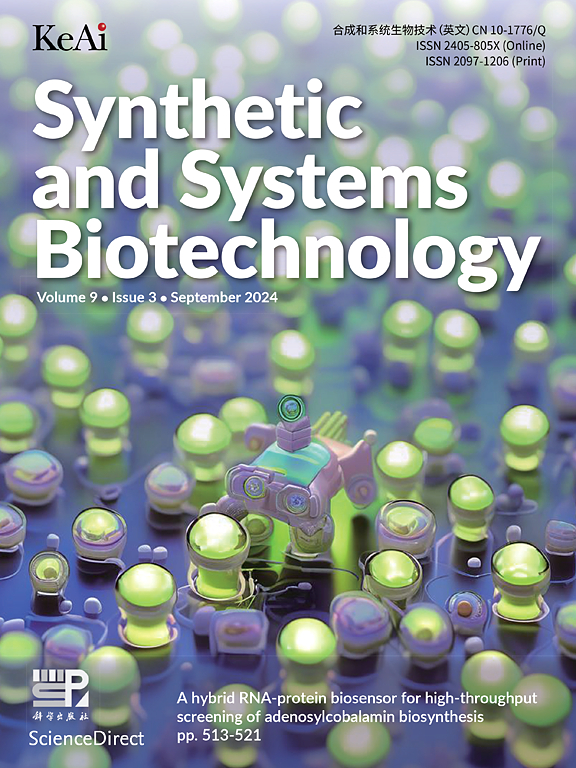大肠杆菌中羊毛甾醇的生物合成
IF 4.4
2区 生物学
Q1 BIOTECHNOLOGY & APPLIED MICROBIOLOGY
引用次数: 0
摘要
脂质组成在细胞生命的三个领域(真核生物、细菌和古细菌)中具有重要的区别。真核生物具有独特的脂质,如固醇和鞘脂,一般来说,这些在典型的细菌和古细菌中并不常见。甾醇在真核生物的细胞功能中起着关键作用,羊毛甾醇是动物和真菌类固醇的关键前体,在真核生物中具有良好的功能,而其在细菌中的潜在功能仍未得到充分研究。在本研究中,我们对大肠杆菌(E. coli)进行了基因工程改造,重建了羊毛甾醇的生物合成过程,并成功开发出一种能够合成羊毛甾醇的新型大肠杆菌菌株,尽管其具体位置,如是否被纳入细胞膜,还有待进一步确定。对观察到的表型变化的综合表征表明,尽管在正常条件下生长速度不变,但工程大肠杆菌菌株对各种胁迫的耐受性明显增强。随后的分析表明,羊毛甾醇在保持膜完整性、流动性、疏水性和ATP产生方面发挥作用,反映了真核生物中甾醇的功能。这项研究揭示了大肠杆菌合成甾醇的意想不到的能力,不仅强调了羊毛甾醇作为必需细胞脂质的前体的重要性,而且为甾醇在细菌系统中的潜在功能提供了新的见解。本文章由计算机程序翻译,如有差异,请以英文原文为准。
Biosynthesis of lanosterol in Escherichia coli
Lipid composition represents a significant differentiator across the three domains (eukaryotes, bacteria, and archaea) of cellular life. Eukaryotes possess distinct lipids, such as sterols and sphingolipids, generally, these are not commonly found in typical bacteria and archaea. Sterols play a pivotal role in eukaryotic cellular functions, lanosterol, a key precursor for animal and fungal steroids, has well established functions in eukaryotes, while its potential functions in bacteria remain largely uninvestigated. In this study, we genetically engineered Escherichia coli (E. coli) to reconstruct the biosynthesis of lanosterol, and successfully developed a novel E. coli strain capable of synthesizing lanosterol, although its specific location, such as whether it is incorporated into the cell membrane, remains to be further determined. Comprehensive characterization of the observed phenotypic changes has unveiled that, despite an unaltered growth rate under normal condition, the engineered E. coli strain displayed notably enhanced tolerance to various stresses. Subsequent analysis has indicated that lanosterol plays a role in preserving membrane integrity, fluidity, hydrophobicity, and ATP production, mirroring the functions of sterols in eukaryotes. This study unveils the unexpected capacity of E. coli to synthesize sterols, not only underscores the importance of lanosterol as a precursor for essential cellular lipids but also offers fresh insights into the potential functions of sterols within bacterial systems.
求助全文
通过发布文献求助,成功后即可免费获取论文全文。
去求助
来源期刊

Synthetic and Systems Biotechnology
BIOTECHNOLOGY & APPLIED MICROBIOLOGY-
CiteScore
6.90
自引率
12.50%
发文量
90
审稿时长
67 days
期刊介绍:
Synthetic and Systems Biotechnology aims to promote the communication of original research in synthetic and systems biology, with strong emphasis on applications towards biotechnology. This journal is a quarterly peer-reviewed journal led by Editor-in-Chief Lixin Zhang. The journal publishes high-quality research; focusing on integrative approaches to enable the understanding and design of biological systems, and research to develop the application of systems and synthetic biology to natural systems. This journal will publish Articles, Short notes, Methods, Mini Reviews, Commentary and Conference reviews.
 求助内容:
求助内容: 应助结果提醒方式:
应助结果提醒方式:


